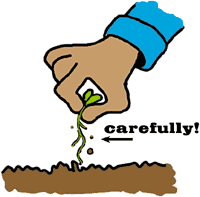Seed Starter Unit
Seeds for annuals usually have to be started indoors 6 to 8 weeks before you can plant the seedlings in your outdoor garden. For example: In Zone 4 Canada plants can go outdoors around May 24. Therefore they need to be started indoors around the end of March. If the seeds are very small you may want to use a different method to start tiny seeds. One of the easiest seed starter units that you can make yourself can be used for regular size seeds. You will need:
- 2 empty, clean margarine tubs with lids for each unit,
- a pencil, a ruler, a sharp knife and a pair of scissors
- several pair of clean, used panty hose cut into 12 inches long (30 cm) lengths. Ask mum first before you cut hers up!
- You can use any absorbent fabric cut into strips 1" wide (2.5 cm) by 12" long (30 cm). Make sure it is clean and doesn’t have any dye or laundry soap left in it.
- a bag of vermiculite which you can purchase at a garden store or nursery.
The Seed Pot:

- Ask an adult for help when using sharp cutting tools.
- Make a hole in the bottom of 1 of the tubs about ½ inch across (1.5 cm).
The Water Reservoir:
- Cut 2 holes in a lid, 1 in the center about 3/4 inches across (2 cm) and the other one about 1 inch across (2.5 cm) near the edge of lid. This second hole is where you’ll add water to the reservoir.
- Use a length of panty hose or fabric as a wick to draw water up from the reservoir into the seed pot.
- Feed 2/3 of the wick through the hole in the center of the lid and push about 1/3 of it down into the water reservoir.
- Fill the reservoir ¾ full with room temperature water and snap on the lid with the rest of the wick sticking out the top.
Assembling the Seed Starter Unit:
- Carefully feed the wick up through the hole in the bottom of the seed pot.
- Place it on top of the water reservoir and gently pull on the wick so there isn’t a bunch stuck between the 2 pots.
- Put in some vermiculite while you hold onto wick to keep it from getting buried at the bottom.
- Once the pot is about half full lay the wick around the edge of the seed pot.
- Now your seed pot is ready for use.
Planting the Seeds:
- Read each seed package to see how deep the seeds need to be planted.
- Use a pencil and ruler to make a hole at the required depth and drop in a seed. You can put several seeds into one pot if you like, but don't overfill it.
- Fill in the hole with more vermiculite and gently sprinkle with water, ensuring neither the vermiculite nor the seeds start to float.
- Place the seed starter unit in a sunny window and keep the water reservoir ¾ full.
- Your seed packets will tell you how long it takes for the seeds to germinate.
- When the first two leaves sprout, rotate the pot gently every couple of days so the seedling will grow straight.
- If your plants become too crowded, you can thin them or discard the weaker ones.

- Use a fork to loosen the roots while gently holding the seedling by the leaves as you lift it out.
- Transplant it to another pot filled with soil.
- The week before you put your seedlings in the garden, they will need to be hardened off before you place them in the ground.
planting
|



